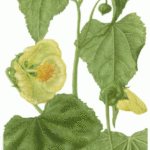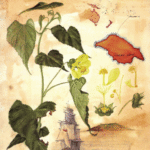
Pitcairn island
Pitcairn Island is the infamous hideout of the Bounty mutineers; it is an extremely isolated island at the southeast of the main group of Polynesian Islands, and roughly situated half way between New Zealand and South America and just south of the tropic of Capricorn. Rising to just 330m above sea level, Pitcairn is scarcely 3km by 2km in size. Pitcairn lies within a group of four islands, which are part of the UK Overseas Territories. The group comprises two atolls, Oeno and Ducie (the most southerly atoll on earth), the raised atoll Henderson (a world heritage site), and the high volcanic island Pitcairn.

Project Description
Abutilon pitcairnense (above) is a highly attractive yellow flowered member of the Malvaceae and is a horticultural worthy species whose eventual commercialisation could support plant conservation activities on the island. The species, only described in 1981, is currently extinct in the wild. Islander Carol Warren refound it in 2003, after a period of over 20 years, during which time it was presumed extinct. The plant was rediscovered in ‘mixed native forest’ dominated by Homalium taypau and Metrosideros collina (Kingston & Waldren, 2003). Cuttings and seed were obtained from this sole individual and they were sown and grown in the island nursery. In 2005 the sole plant was destroyed in a landslide (Smyth 2010). Homalium taypau forest is under threat on the island and is being out competed by the non-native, introduced species Syzygium jambos (Roseapple) and other invasive species such as Lantana camara. Experiments on the chemical control of these invasive aliens, and efforts to restore native vegetation afterwards during 2003-2006 were successful (Smyth 2008, 2010). Through combining invasive species control, restoration of native vegetation and the proposed reintroduction of Abutilon pitcairnense to various parts of the island, a holistic approach to target species conservation and restoration of its endangered associated habitat will hopefully be achieved.
Kingston, N. & Waldren, S. (2003). The plant communities and environment gradients of Pitcairn Island: The significance of invasive species and the need for conservation management. Annals of Botany 92: 1–10.
Kingston, N. & Waldren, S. (2005) A conservation appraisal of the rare and endemic vascular plants of Pitcairn Island. Biodiversity and Conservation 14: 781-800.
Smyth, N. (2008). Syzygium jambos (L). Alson (Myrtaceae) control, and conservation, restoration and monitoring of the threatened native flora of Pitcairn Island, South Central Pacific. PhD. Thesis. University of Dublin, Trinity College, Dublin 2.
Smyth, N. (2010). Abutilon pitcairnense. MALVACEAE. Plants in Peril. 35. Curtis’s Botanical Magazine. Vol.27. Part 4. Pp.355-363.
Project Aims
- A full methodological search of Pitcairn Island for more plants of Abutilon pitcairnense during its known flowering season (July & August) on Pitcairn Island. Searches for the plant in the past were carried out when the plant was not flowering, as the flowering time was unknown.
- Production of plant cuttings at the island nursery from the seedlings obtained in 2004.
- Support for detailed pollinator observations during Abutilon pitcairnense flowering season on Pitcairn Island (July & August).
- Support to maintain a full collection of the known genotypes of Abutilon pitcairnense on Pitcairn Island, at the National Botanic Gardens, Glasnevin and at Trinity College Botanic Gardens as an ex situ “insurance collection” and experimental collection for species recovery efforts. Currently only the cutting from the original is in ex situ conservation at these institutions. Cuttings from the seedlings obtained are required to carry out the cross-pollination experiments.
- Support to obtain and grow more seedlings after cross-pollination experiments for genetic analysis at the National Botanic Gardens, Glasnevin. Attempt crosses of the most genetically dissimilar individuals in order to increase the diversity of progeny. The most genetically distinct genotypes can be bulked up using tissue culture facilities at the National Botanic Gardens. Repeated selfing of original plant to yield more progeny, develop markers to track each genet.
- All genetically distinct material generated by experiment for re-introduction to suitable locations on Pitcairn. Use mixed plantings facilitate geneflow and thereby maximise the diversity of progeny.
- Attempt crosses of the most genetically dissimilar individuals in order to increase the diversity of progeny.
- To record detailed ecological data on vegetation associations, soil type and habitat if refound in the wild.
- Painting of Abutilon pitcairnense executed for Curtis’s Botanical Magazine.
- Print ca 50×30 cm of HMS Bounty approaching Pitcairn Island in 1790.
Artwork in support of Endemic Plant Conservation on Pitcairn Island
Susan Sex the renowned botanical artist has painted Abutilon pitcairnense in a plate which depicts the location of Pitcairn Island and the arrival of the Bounty Mutineers to the island in 1790. This limited edition print (500 only) is available on Pitcairn Island and from the Visitor Centre at the National Botanic Gardens, Glasnevin. The Botanical plate of the species from the recent Curtis magazine paper are also available as card packs.
Some Project Results to Date
Pollinator visitation observations of Abutilon pitcairnense over a five day period on Pitcairn Island carried out by Carol Warren in July/August 2010. Ants appeared on day one and two of flower opening then visited no more. Bees visited the flowers more frequently over the five day period being most active in the afternoons.
Results of cross pollination to develop a new cultivar carried out at Glasnevin by Glasshouse Foreman Brendan Sayers. Seed were obtained from a cross with Hibiscus boryanus.
Seed Banking
2010 Seed Harvest in Glasnevin Botanic Gardens, Dublin & Pitcairn Island, South Central Pacific. The seed collected were sown or seed banked at Glasnevin, Trinity, Kew, The Millennium seedbank and on Pitcairn Island.
Project Staff and Partners
The people of Pitcairn Island and the Mohammed Bin Zayed Conservation Fund are thanked for supporting the research work on Pitcairn and at Glasnevin.
Further project information is available on the MBZ website.


